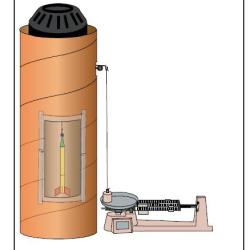Source Institutions
Source Institutions
Add to list Go to activity
Activity link broken? See if it's at the internet archive

In this activity, learners evaluate the potential performance of air rockets placed inside a wind tunnel. Learners measure the rocket's resistance to the flow of air in the tunnel and use the data to construct better rockets. The wind tunnel is prepared by the educator before the activity, but can be built by learners with adult supervision. This lesson plan includes instructions on how to build and use a wind tunnel, extensions, and sample data sheets.
- 1 to 2 hours
- 45 to 60 minutes
- Over $20 per group of students
- Ages 8 - 18
- Activity, Experiment/Lab Activity, Lesson/Lesson Plan, Model
- English
Quick Guide
Materials List (per group of students)
- Paper concrete tube form (8" or 12" by 4')
- Beam balance or electronic scale (sensitive to 0.1 grams)
- Balance or some other weight
- Thin wire coat hanger
- Nail (about 16D by 3")
- 2 small screw eyes
- String
- Duct Tape
- Transparency paper or clear cellophane
- Small electric fan
- Needle-nose pliers
- Wire cutter
- Box cutter
- Ruler
- Toilet paper roll tubes (about 24)
- Hot glue
- Flashlight
- Adhesive or gummed paper reinforcing wings
- High Power Paper Rockets
- Data sheets
- Pencils
Subjects
-
Earth and Space Science
-
Earth Structure
- Atmosphere
-
Earth Structure
-
Engineering and Technology
-
Engineering
- Aerospace Engineering
-
Engineering
-
Mathematics
-
Data Analysis and Probability
- Data Analysis
- Data Collection
- Data Representation
-
Measurement
- Size and Scale
- Number and Operations
-
Data Analysis and Probability
-
Physical Sciences
-
Energy
- Work and Machines
-
Motion and Forces
- Gravity
-
Structure and Properties of Matter
- Mass and Weight
-
Energy
-
The Nature of Science
-
The Scientific Process
- Asking Questions
- Conducting Investigations
- Gathering Data
- Formulating Explanations
- Communicating Results
-
The Scientific Process
-
The Nature of Technology
-
The Design Process
- Research and Development
- Problem Solving
- Troubleshooting and Maintenance
-
The Design Process
Informal Categories
- Model Building
- Outdoor Activity
- Toys
- Transportation
Audience
To use this activity, learners need to:
- see
- read
- be mobile
- touch
Learning styles supported:
- Involves hands-on or lab activities
Other
Includes alignment to state and/or national standards:
Includes assesments for student learning:
This resource is part of:
Access Rights:
- Free access
By:
- NASA
